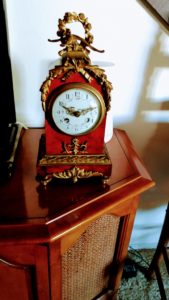 NP’s aunt, a fan of anything Viennese, bequeathed NP a beautiful clock made by the famous French clockmaking family Japy Freres. MP sent me a photo of her lovely, delicate mantle clock. Founded in 1806 by father Frederic and later joined by his three sons, Japy Freres serves as an early model of diversification of talents. Pierre handled the finances, Fritz tackled the technical end, and Louis took over the watchmaking machinery. Father Frederic acted as the brains and the boss. Thus, an industry of “made by hand” became, by the early 19th century, a Japy Freres factory production out of one large building in Besancourt, France. The business thrived for 124-years. It closed after the family supplied clocks and watches to various national armies gearing up for World War II.
NP’s aunt, a fan of anything Viennese, bequeathed NP a beautiful clock made by the famous French clockmaking family Japy Freres. MP sent me a photo of her lovely, delicate mantle clock. Founded in 1806 by father Frederic and later joined by his three sons, Japy Freres serves as an early model of diversification of talents. Pierre handled the finances, Fritz tackled the technical end, and Louis took over the watchmaking machinery. Father Frederic acted as the brains and the boss. Thus, an industry of “made by hand” became, by the early 19th century, a Japy Freres factory production out of one large building in Besancourt, France. The business thrived for 124-years. It closed after the family supplied clocks and watches to various national armies gearing up for World War II.
A New Way to Make Clocks
The founder, father Frederic, apprenticed with his grandfather, a watchmaker. After his apprenticeship, in 1766, at the age of 17, he began to reform the clockmaking industry. Prior to Frederic’s innovations, different villagers made different watch parts. An “assembler” then joined the parts, and forwarded them to a “dresser” who made the case. Frederic standardized the industry. He purchased and remade machinery, and assembled a factory where all workmen toiled under one roof, in sequence, on site. When we talk about the Enlightenment period in Europe, the best metaphor comes from Newton’s dictum that the universe is a clockwork mechanism, and that all human beings are parts of that machine.
NP feels grateful to his friends James and Donna Stoudemire of Clockworks, in Huntington Maine, for the identification and dating of this clock. NP’s aunt’s clock, circa 1880, exhibits the fruits of founder Frederic’s innovations. The screws are machine made, as opposed to hand-turned, and the treatment of the case and the enamel process of the dial unique for this time. Frederic invented the process in the 18th century. And to own a timepiece in the 18th century was a privilege for the wealthy. I find a further metaphor for the importance of timekeeping in the era. Clockmakers designed them for the central position in the home, above the hearth, which warmed the entire house. Thus the name mantle clocks. People converged around the hearth, and a timepiece became a status-marking symbol of order and control in the 18th century.
Japy Freres focused on making thousands of high-end clocks
The wealthy all over Europe desired a Japy Freres mantel, or bracket clock, a tall clock designed to sit on a matching wall bracket. Yet when his sons inherited the business in the early 19th century, they began to “diversify.” They made office machines, hardware, enamel kitchenware, and coffee grinders. You can guess the result, the factory became spread too thin. Those high-end clocks, the cornerstone of the business, suffered. Luckily for NP, his aunt’s clock falls into the higher end of the refinement scale. Japy Freres continued as a symbol of taste in timepieces until the third quarter of the 19th century. In fact, Japy Freres set the standard for classy clocks being necessarily of French manufacture and French design, and available only to those of discriminating taste.
NP’s clock sports the French Revival style of the late 19th century, specifically the Louis XV style. The case appears distinctive for its mottled orange to brown, which is called Boulle Work. This style comes from French cabinet maker Andre Charles Boulle (1642-1732), who veneered furniture and clocks with tortoiseshell. Japy’s clocks simulate this look with enamel. NP mentioned that his aunt loved the Viennese style. This clock ‘fits’ with her taste, as the wealthy of Vienna favored the Louis XV Revival style. We see the grace, proportion, and organic whiplash line of Louis XV Revival today in vintage Viennese architecture.
The Value
The workings of the clock are initialed B&G, which may refer to the porcelain manufacturer Bing and Grondahl. That made the clock more expensive when originally purchased. The clock is ornamented with doré-work (gold-gilded bronze) mounts that terminate in a flower cartouche on which a bird landed.
The clock’s workings were pulled, and changed to battery operation years ago. But NP writes that the clock sounds “noisy,” indicating the metal workings are still intact. I put the value, once the original workings are restored, at $1,000.
Pingback: Regulator Clock Hidden Danger - Elizabeth Appraisals